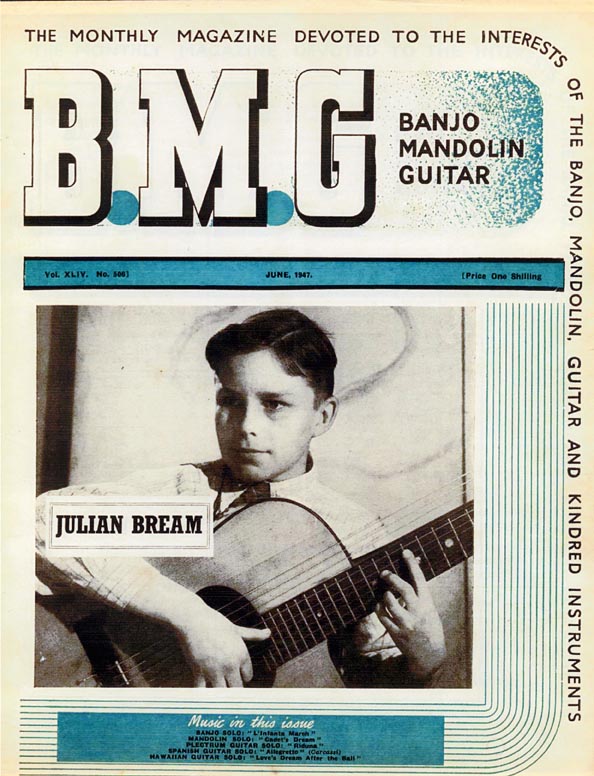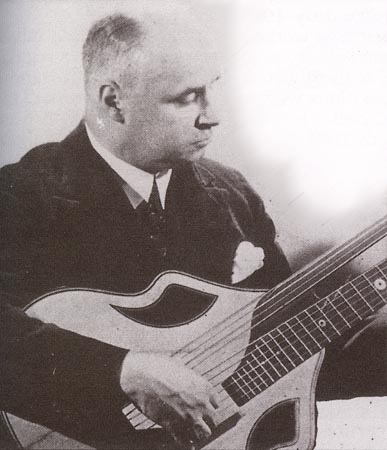| That is 13-year-old Julian Bream, about to make his
classical guitar performing debut!
The story goes that Bream (just on the cusp of discovery) was
visiting the London offices of Banjo, Mandolin & Guitar Magazine, harp
guitar in tow. A couple photos were
taken, and one was used on the next cover in June 1947.

(image courtesy of Randy Osborne at Fine Fretted
Instruments)
But how in the world did young Bream come to
acquire a Maccaferri harp guitar, and what happened to it?
It wasn't until I had actually posted a simpler
version of this article that I learned the (nearly) whole remarkable
story from Stuart Button's marvelous 2006 book, Julian Bream: The
Foundations of a Musical Career. I would recommend that
everyone read it, as Button devotes a whole chapter to this story - one
of a very few that presents a detailed historical picture of the clash
between the 6-string guitar and harp guitar - perhaps the latter's "last
chance" in the classical guitar world (until today's resurgence).

Dr. Boris Perott (physician, and
president of the PSG)
Button shows (through surviving letters) that
Bream's first guitar teacher,
Boris Perott, happened to own a ten-course (4+6) wappen-shape
Russian harp guitar (above), and actively advocated the
use of extra strings. More significantly, Bream's father Henry (an amateur
guitarist), after hearing the tone and projection of Perott's
instrument, became completely convinced of the merit of a harp guitar for offering
more sound and additional voicings. Henry was so taken with
Perott's instrument that he incorporated it into the new logo of London's Philharmonic Society of
Guitarists (below), of
which he was then librarian and Dr. Perott president.

In fact, Henry was so confident that a guitar
with extra strings was the right instrument for his prodigy son that he
took it upon himself to acquire one - and found at Selmer's London
facility this second-hand Maccaferri, said to be the Maestros' own
concert guitar. It appears that it was unlabeled, but that the
Selmer manager, one Ben Davies, had organized some of Maccaferri's
recitals and "verified" that this was indeed Maccaferri's
recital guitar. Henry stated in his August 26, 1946 letter that he
intended to write Maccaferri (now in New York) directly about the
provenance, but no result to this inquiry seems to be known. My
suspicion is that, as just another of Maccaferri's endless evolutionary
experiments (see The Harp Guitars of Mario Maccaferri), it may very well be that he performed
on it for a short period. However, as he has not been seen
photographed with this specimen, and otherwise seems to have clearly
preferred models with a hollow, single arm (see
Player of Month),
it is equally likely that Maccaferri used it little or not at all, and
that Davies was embellishing its provenance for a sale.
Henry
describes "two soundboards, a tone reflector," and a "beautifully
carved back." Clearly, this is an important instrument for
the study on the development of Maccaferri and Selmer guitars!
Henry further described it as "certainly the best guitar we have
met with."
Julian Bream (who on
the DVD, refers to it simply as a "nine-string guitar" - which
is also what Maccaferri would have advertised it as) immediately began
using the Maccaferri, playing it at meetings of the PSG, where it
immediately caused controversy. It is worth noting that it appears
from Mr. Bream's correspondence that Julian was, in fact, using the
extra strings for certain pieces in these early performances (only one is named: "I Capuletti
ed I Montecchi" by Bellini) - in
essence, he temporarily became a true "harp guitarist."
Alas, two events conspired to derail young Julian's erstwhile harp
guitar career: The first was that Wilfred Appleby, the editor of
the PSG's Bulletin, and most vocal member of the Society, was
totally against what he referred to as "Maccaferri's monstrosity," "that
'fool guitar'," and "freak instrument." Appleby also wrote that
"no music requiring extra strings is really representative guitar music,
so it can be ignored..." Ouch! As the promoter of young
Julian's debut concert, Appleby was adamant that he play a "normal"
classical guitar, and of course won the argument, lending Bream a
six-string instrument which he had to very quickly adapt to. The
second event was that Bream had also just abandoned the
extra-strings-advocating Perott as a mentor and teacher,
due to Perott's instruction to keep the "pinky" anchored to
the soundboard, which Bream realized even at his tender age would ruin
his ability to play the Spanish repertoire.
Thus begins and ends the career of the most celebrated almost-harp-guitarist
of our time. Ironically Bream did take up another multi-course
instrument later in his career - the lute. What might have
happened to the harp guitar world today if he had instead simply picked
up his old Maccaferri to play lute repertoire? Oh, to think what
might have been!

(image copyright Music on Earth)
|






